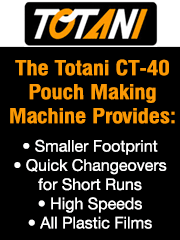The Third Wave: An Iron Tale about the Business of Print, Vol. 8
- Published: August 01, 2002, By Susan Kelly, Raine Consulting
This column is the eighth in a yearlong series of columns about the challenges facing the converting industry. Through our 2002 series of print and web articles, Raine provides critical insights, specific industry examples, and thought-provoking ideas about how technology is impacting converters today.
Finding New Opportunities for Advantage
Over time, converted products have been categorized as "indirect spend" by customers who relegate them to stock keeping units (SKUs) that can be bid out easily. However, new research indicates there may be new opportunities on the horizon depending on how and what a customer buys. Variable-data programs and convert-on-demand products are demonstrating cost savings too hard to ignore by any buyer.
The Direct/Indirect Spend Difference
Print buying is a direct spend when it is part of the core supply chain (primarily publishers for books, magazines, catalogs, and newspapers). A converter or printer is a direct supplier when he or she is a major contributor to a customer’s supply chain. The role of a direct supplier is critical to the success of any customer. If a catalog is poorly printed, it hurts the publishing company’s business. These products tend to be big repeatable items. What’s scary is recent research shows these products are going commodity, just as fast, if not faster, than many converting products.
Indirect spend is when print is non-core to the customer’s supply chain and tends to be purchased by marketing, administration, and operations support organizations. Print quickly gets classified as commodities or MROs (maintenance, repairs, and operations). We see this most clearly in traditional manufacturing industries. And we continue to see strong activity in this arena around enterprise sourcing initiatives, auctions, and supplier-consolidation programs.
In a recent Raine survey, over 65% of the buyers reported reducing the number of suppliers. Also not surprising, the survey showed 86% were fully aware of the overcapacity situation in converting markets, and 47% openly stated they would use this leverage to get lower prices.
The April 2002 report on e-business by NAPM (National Association of Purchasing Managers) and Forrester Research documents: 70% of organizations use the Internet for request for proposals and 20% of buyers use auctions. This report also found that the Internet absolutely remains an important part of supply-management’s plans. However buyers also understand the efforts required for integrating online buying efforts with internal systems as well as the need for continuous bankable cost savings.
Fact: Direct spend is going commodity faster than indirect spend. Indirect spend is going variable faster than direct spend.
The opportunities for advantage can be found in variable programs for large purchases of indirect spend: namely converting products. The cost savings that can be driven by variable data programs as well as convert-on-demand products can provide one of the biggest growth opportunities for converting businesses today.
Understanding the impact of how this generates sales with these new kinds of buyers is crucial. Decreased staffing and increased workloads (dollars purchased per person) in customers' organizations are driving immediate needs for new solutions to make a buyer’s life easier. Additionally, anything that helps buyers with their reporting needs -- both standardized and customized reporting capabilities -- is a huge value-added service.
Enter CRM… and the need to connect the customer’s customer actions with supplier actions and to drive costs out of the marketing and procurement workflows will be critical within the next 2 to 3 years.
And it looks as if there's no turning back. By changing not only their processes but also how they interact with their suppliers, variable-data programs and convert-on-demand products will continue to take on a larger role within supply management organizations. The evidence (increasing numbers) is starting to come in, and it is compelling.
This article is excerpted from the Raine whitepaper The Third Wave: An Iron Tale about the Business of Print, downloadable free of charge from RaineConsulting.com.













